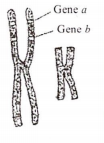 Multiple Choice Questions
Multiple Choice QuestionsIn which one of the following sets of three items each belong to the category mentioned against them
Lysine, glycine, thiamine - amino acids
Myosin, oxytocin and gastrin - hormones
Rennin, helicase and hyaluronidase - enzymes
Optic nerve, oculomotor, vagus - sensory nerves
C.
Rennin, helicase and hyaluronidase - enzymes
Rennin, helicase and hyaluronicasc are all enzymes.
Rennin (chymosin), secreted by the stomach is responsible for clotting milk. It acts on a soluble milk protein (caseinogen) to converts it into the insoluble form casein.
Helicase unwinds double stranded helical DNA during replication.
Hyaluronidase is able to digest hyaluronic acid (major glycosaminoglycan) and is therefore important in modulating the removal of cell matrix in order to facilitate cell movement or tissue organization.
Thiamine is not an amino acid, it is vitamin B1, which is active in the form of thiamin pyrophosphate, a coenzyme in decarboxylation reactions in carbohydrate metabolism. A deficiency of vitamin B1 leads to beriberi.
Myosin is a contractile protein found in eukaryotic tissue. interacts with actin to bring about contraction of muscle or cell movement. Among optic, oculomotor and vagus, which are cranial nerves, optic is sensory in nature, oculomotor is motor and vagus is mixed sensory nerves.
Given below is a highly simplified representation of the human sex chromosomes from a karyotype

The gene a and b could be of
colour blindness and body height
attached ear lobe and Rhesus blood group
haemophilia and red-green colour blindness
phenylketonuria and haemophilia
Pollution from animal excreta and organic waste from kitchen can be most profitably minimized by
storing them in underground storage tanks
using them for producing biogas
vermiculture
using them directly as biofertilizers
Genes present in the cytoplasm of eukaryotic cells are found in
mitochondria and inherited via egg cytoplasm
lysosomes and peroxisomes
Golgi bodies and smooth endoplasmic reticulum
plastids and inherited via male gamete
When children play bare footed in pools of ditty water and flood water, they may suffer from disease like
leptospirosis and bilharzia
malaria, amoebic dysentery and leptospirosis
bilharzia, infective hepatitis and diarrhoea
guinea worm infection, elephantiasis and amoebic dysentery.
Which one of the following is an environment related disorder with the correct main cause
Black lung disease (pneumoconiosis) found mainly in workers in stone quarries and crushers.
Blue baby disease (methaemoglobinaemia) due to heavy use of nitrogenous fertilizers in the area.
Non-hodgkin's lymphoma found mainly in workers involved in manufacture of neem based pesticides.
Skin cancer mainly in people exposed to benzene and methane.
In the following table identify the correct matching of the crop, its disease and the corresponding pathogen.
| Crop | Disease | Pathogen |
| Citrus | Canker | Pseudomonas rubrilineans |
| Potato | Late blight | Fusarium udum |
| Brinjal | Root-knot | Meloidogyne incognita |
| Pigeon | pea Seed gall | Phytophthora infestans |
In which one of the following combinations (a-d) of the number of chromosomes is the present day hexaploid wheat correctly represented
| Combination | Monosoic | Haploid | Nullisomic | Trisomic |
| (a) | 21 | 28 | 42 | 43 |
| (b) | 7 | 28 | 40 | 42 |
| (c) | 21 | 7 | 42 | 43 |
| (d) | 41 | 21 | 40 | 43 |
Hirudin is
a protein produced by Hordeum vulgare, which is rich in lysine
a toxic molecule isolated from Gossypium hirsutum, which reduces human fertility
a protein produced from transgenic Brassica napus, which prevents blood clotting
an antibiotic produced by a genetically engineered bacterium, Escherichia coli.
mong rust, smut and mushroom all the three
are pathogens
are saprobes
bear ascocarps
bear basidiocarps.
